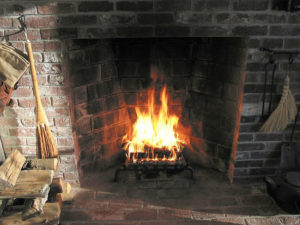 If you have an open-hearth wood-burning fireplace, your hearth provides more ambiance than heat. In fact, 90 percent of the heat from an open-hearth fireplace travels up the chimney. At the same time, the fireplace draws in warm air from your room to fuel the flames, which means you are likely losing more heat than you are gaining from your fireplace.
If you have an open-hearth wood-burning fireplace, your hearth provides more ambiance than heat. In fact, 90 percent of the heat from an open-hearth fireplace travels up the chimney. At the same time, the fireplace draws in warm air from your room to fuel the flames, which means you are likely losing more heat than you are gaining from your fireplace.
Even though open-hearth fireplaces can be a heat drain, there are some steps you can take to improve the efficiency of your fireplace.
Burn only dry, seasoned firewood
An efficient fire begins with the right fuel. For a wood-burning fireplace, that means dry, seasoned firewood. Wet wood burns cool. It hisses and sizzles and steams and quickly clogs your chimney with creosote. By burning firewood that has been dried for at least six months, you’ll burn a hotter, cleaner, more efficient fire. Wood that’s seasoned and ready to burn will be gray in color and cracked; it will seem light in weight for its size; and the bark will be pulling away from the wood. It will light easily and crackle pleasantly while it burns.
Make sure your damper is fully opened
When your damper is fully open your fireplace can draft properly: Air is drawn into the fireplace to fuel the fire, and then rises up and out of the chimney. While it might seem that a partially closed damper would help to keep heat it, closing your damper part way is actually counterproductive. With the damper partially closed, the fire won’t be able to draw in the air it needs, which means it will not burn efficiently.
Have your chimney swept
Just like your fireplace can’t draw enough air to fuel an efficient fire when the damper is partially closed, it also can’t draw enough air to fuel the fire when your chimney is dirty and blocked by creosote, natural debris or animal nests. Having your chimney swept at least once a year ensures that it’s fully opened and that your fire will be able to breathe properly.
Install tempered glass doors
If your fireplace has, or came with, glass doors, chances are the doors’ primary purpose is to block a draft from the chimney when the fireplace isn’t in use. They should never be closed when the fireplace is in use, as they can crack or explode from the heat and pressure. There are, however, tempered glass doors that are designed to regulate air flow to your fireplace and increase its efficiency. Installing these tempered glass doors can increase your fireplace’s efficiency to around 20 percent.
Consider a fireplace insert
If you have an open-hearth fireplace, the best way to increase its efficiency is by installing a fireplace insert. If you prefer to stay with a wood-burning fireplace, an EPA-certified wood-burning insert can have an efficiency of up to 80 percent. If you’re willing to switch to clean-burning natural gas, efficiency can range from 85 to 99 percent, depending on the type of fireplace you choose.
Call Environmental Chimney Service today!
If you’re ready to increase the efficiency of your fireplace, call Environmental Chimney Service today. We can sweep your chimney, install glass doors or talk to you about your insert options to help you improve your fireplace’s performance.
